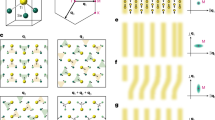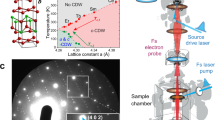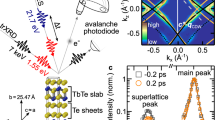Abstract
Upon excitation with an intense laser pulse, a symmetry-broken ground state can undergo a non-equilibrium phase transition through pathways different from those in thermal equilibrium. The mechanism underlying these photoinduced phase transitions has long been researched in the study of condensed matter systems1, but many details in this ultrafast, non-adiabatic regime still remain to be clarified. To this end, we investigate the light-induced melting of a unidirectional charge density wave (CDW) in LaTe3. Using a suite of time-resolved probes, we independently track the amplitude and phase dynamics of the CDW. We find that a fast (approximately 1 picosecond) recovery of the CDW amplitude is followed by a slower re-establishment of phase coherence. This longer timescale is dictated by the presence of topological defects: long-range order is inhibited and is only restored when the defects annihilate. Our results provide a framework for understanding other photoinduced phase transitions by identifying the generation of defects as a governing mechanism.
This is a preview of subscription content, access via your institution
Access options
Access Nature and 54 other Nature Portfolio journals
Get Nature+, our best-value online-access subscription
$29.99 / 30 days
cancel any time
Subscribe to this journal
Receive 12 print issues and online access
$209.00 per year
only $17.42 per issue
Buy this article
- Purchase on Springer Link
- Instant access to full article PDF
Prices may be subject to local taxes which are calculated during checkout




Similar content being viewed by others
Data availability
The datasets generated and analysed during the current study are available from the corresponding author on reasonable request.
References
Nasu, K. (ed.) Photoinduced Phase Transitions (World Scientific, Singapore, 2004).
Goldenfeld, N. Lectures on Phase Transitions and the Renormalization Group (Westview, Boulder, 1992).
Kibble, T. W. B. Topology of cosmic domains and strings. J. Phys. A 9, 1387–1398 (1976).
Zurek, W. H. Cosmological experiments in condensed matter systems. Phys. Rep. 276, 177–221 (1996).
Bowick, M. J., Chandar, L., Schiff, E. A. & Srivastava, A. M. The cosmological Kibble mechanism in the laboratory: string formation in liquid crystals. Science 263, 943–945 (1994).
Chuang, I., Durrer, R., Turok, N. & Yurke, B. Cosmology in the laboratory: defect dynamics in liquid crystals. Science 251, 1336–1342 (1991).
Ruutu, V. M. H. et al. Vortex formation in neutron-irradiated superfluid 3He as an analogue of cosmological defect formation. Nature 382, 334–336 (1996).
Bäuerle, C., Bunkov, Y. M., Fisher, S. N., Godfrin, H. & Pickett, G. R. Laboratory simulation of cosmic string formation in the early Universe using superfluid 3He. Nature 382, 332–334 (1996).
Yusupov, R. et al. Coherent dynamics of macroscopic electronic order through a symmetry breaking transition. Nat. Phys. 6, 681–684 (2010).
Mertelj, T. et al. Incoherent topological defect recombination dynamics in TbTe3. Phys. Rev. Lett. 110, 156401 (2013).
Baum, P., Yang, D.-S. & Zewail, A. H. 4D visualization of transitional structures in phase transformations by electron diffraction. Science 318, 788–792 (2007).
Lee, P. A. & Rice, T. M. Electric field depinning of charge density waves. Phys. Rev. B 19, 3970–3980 (1979).
Grüner, G. Density Waves in Solids (Addison-Wellesley, Boston, 1994).
Hoesch, M., Bosak, A., Chernyshov, D., Berger, H. & Krisch, M. Giant Kohn anomaly and the phase transition in charge density wave ZrTe3. Phys. Rev. Lett. 102, 086402 (2009).
Girault, S., Moudden, A. H. & Pouget, J. P. Critical X-ray scattering at the Peierls transition of the blue bronze. Phys. Rev. B 39, 4430–4434 (1989).
Holt, M., Zschack, P., Hong, H., Chou, M. Y. & Chiang, T.-C. X-ray studies of phonon softening in TiSe2. Phys. Rev. Lett. 86, 3799–3802 (2001).
Ru, N. et al. Effect of chemical pressure on the charge density wave transition in rare-earth tritellurides RTe3. Phys. Rev. B 77, 035114 (2008).
Fultz, B. & Howe, J. Transmission Electron Microscopy and Diffractometry of Materials 4th edn (Springer, Berlin, 2013).
Kabanov, V. V., Demsar, J., Podobnik, B. & Mihailovic, D. Quasiparticle relaxation dynamics in superconductors with different gap structures: theory and experiments on YBa2Cu3O7−δ. Phys. Rev. B 59, 1497–1506 (1999).
Demsar, J., Biljaković, K. & Mihailovic, D. Single particle and collective excitations in the one-dimensional charge density wave solid K0.3MoO3 probed in real time by femtosecond spectroscopy. Phys. Rev. Lett. 83, 800–803 (1999).
Yusupov, R. V., Mertelj, T., Chu, J.-H., Fisher, I. R. & Mihailovic, D. Single-particle and collective mode couplings associated with 1- and 2-directional electronic ordering in metallic RTe3 (R=Ho, Dy, Tb). Phys. Rev. Lett. 101, 246402 (2008).
Schmitt, F. et al. Transient electronic structure and melting of a charge density wave in TbTe3. Science 321, 1649–1652 (2008).
Rettig, L. et al. Persistent order due to transiently enhanced nesting in an electronically excited charge density wave. Nat. Commun. 7, 10459 (2016).
Ru, N. & Fisher, I. R. Thermodynamic and transport properties of YTe3, LaTe3, CeTe3. Phys. Rev. B 73, 033101 (2006).
Hu, B. F., Cheng, B., Yuan, R. H., Dong, T. & Wang, N. L. Coexistence and competition of multiple charge-density-wave orders in rare-earth tritellurides. Phys. Rev. B 90, 085105 (2014).
DiMasi, E., Aronson, M. C., Mansfield, J. F., Foran, B. & Lee, S. Chemical pressure and charge-density waves in rare-earth tritellurides. Phys. Rev. B 52, 14516–14525 (1995).
Overhauser, A. W. Observability of charge-density waves by neutron diffraction. Phys. Rev. B 3, 3173–3182 (1971).
Moore, R. G. et al. Ultrafast resonant soft X-ray diffraction dynamics of the charge density wave in TbTe3. Phys. Rev. B 93, 024304 (2016).
Vogelgesang, S. et al. Phase ordering of charge density waves traced by ultrafast low-energy electron diffraction. Nat. Phys. 14, 184–190 (2018).
Chatterjee, U. et al. Emergence of coherence in the charge-density wave state of 2H-NbSe2. Nat. Commun. 6, 6313 (2015).
Kogar, A. et al. Observation of a charge density wave incommensuration near the superconducting dome in CuxTiSe2. Phys. Rev. Lett. 118, 027002 (2017).
Lee, W. S. et al. Phase uctuations and the absence of topological defects in a photo-excited charge-ordered nickelate. Nat. Commun. 3, 838 (2012).
Brouet, V. et al. Angle-resolved photoemission study of the evolution of band structure and charge density wave properties in RTe3 (R=Y, La, Ce, Sm, Gd, Tb, and Dy). Phys. Rev. B 77, 235104 (2008).
Morimoto, Y. & Baum, P. Diffraction and microscopy with attosecond electron pulse trains. Nat. Phys. 14, 252–256 (2018).
Frassetto, F. et al. Single-grating monochromator for extreme-ultraviolet ultrashort pulses. Opt. Express 19, 19169–19181 (2011).
Acknowledgements
We acknowledge discussions with S. Brazovskii, Z. Ding, T. Xie, P. A. Lee, J. Ruhman, B. Skinner, A. Krikun, W. H. Zurek, S.-Y. Xu and D. Chowdhury. We thank M. Bajaj for assistance on instrumentation. We acknowledge support from the US Department of Energy, BES DMSE (experimental setup and data acquisition), from the Gordon and Betty Moore Foundation’s EPiQS Initiative grant GBMF4540 (data analysis and manuscript writing), the Army Research Office (equipment support for the tr-ARPES), and the Skoltech NGP Program (Skoltech-MIT joint project) (theory). Y.-Q.B. and P.J.-H. acknowledge support from the Center for Excitonics, an Energy Frontier Research Center funded by the US Department of Energy, Office of Science, Office of Basic Energy Sciences, under award number DESC0001088, as well as the Gordon and Betty Moore Foundation’s EPiQS Initiative through grant GBMF4541 (sample preparation and characterization). Work at Stanford was supported by the US Department of Energy, Office of Basic Energy Sciences, under contract number DE-AC02-76SF00515 (sample growth and characterization). P.W. was supported in part by the Gordon and Betty Moore Foundation’s EPiQS Initiative through grant GBMF4414. E.B. acknowledges support by the Swiss National Science Foundation under fellowship P2ELP2-172290.
Author information
Authors and Affiliations
Contributions
A.Z., A.K., T.R., C.L., E.B., E.E., and M.B.Y. performed the time-resolved measurements. J.S. and P.W. synthesized single crystals of LaTe3, supervised by I.R.F. Y.-Q.B. prepared and characterized the samples, supervised by P.J.H. B.F., H.Z., T.R., A.Z. and A.K. built the ultrafast electron diffraction setup. T.R., C.L., E.J.S., E.B. and A.Z. built the 10.75 eV beamline for the tr-ARPES setup. E.E. and M.B.Y. built the optical spectroscopy setup. A.Z. and A.K. performed the data analysis with theoretical input from P.E.D., A.V.R. and B.V.F. A.K. wrote the manuscript with crucial input from A.Z., I.R.F., A.V.R., B.V.F., N.G. and all other authors. This project was supervised by N.G.
Corresponding author
Ethics declarations
Competing interests
The authors declare no competing interests.
Additional information
Publisher’s note: Springer Nature remains neutral with regard to jurisdictional claims in published maps and institutional affiliations.
Supplementary information
Supplementary Information
Supplementary Figure 1–7; References 36–42
Rights and permissions
About this article
Cite this article
Zong, A., Kogar, A., Bie, YQ. et al. Evidence for topological defects in a photoinduced phase transition. Nature Phys 15, 27–31 (2019). https://doi.org/10.1038/s41567-018-0311-9
Received:
Accepted:
Published:
Issue Date:
DOI: https://doi.org/10.1038/s41567-018-0311-9
This article is cited by
-
Ultrafast formation of topological defects in a two-dimensional charge density wave
Nature Physics (2024)
-
Few-electron correlations after ultrafast photoemission from nanometric needle tips
Nature Physics (2023)
-
Coherent correlation imaging for resolving fluctuating states of matter
Nature (2023)
-
Transient dynamics of the phase transition in VO2 revealed by mega-electron-volt ultrafast electron diffraction
Nature Communications (2023)
-
Light-induced hexatic state in a layered quantum material
Nature Materials (2023)



